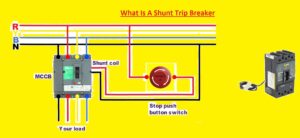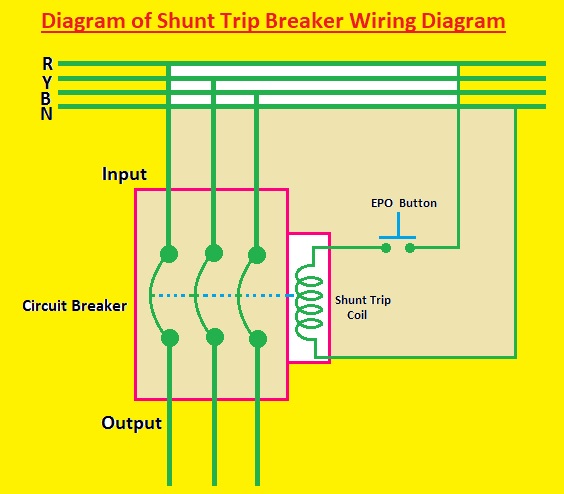Hello readers welcome to the new post. In this post, we will learn What Is A Shunt Trip Breaker & How Does It Work. Detailed Guide. There is electrical system safety is the main parameter for the power system/ The main element that ensures the safety of electrical installation is the shunt trip breaker. In this post, we will discuss the all details shunt trip breaker and other parameters. So let’s get started What is a shunt trip
What is a Shunt Trip Breaker?
If the circuit breaker trips it finds faults condition and automatically shuts off the current flow to prevent the circuit from overheating. The shunt trip breaker is an optional device for a circuit breaker that helps to trip the breaker remotely in any instant or automatically in case of surge saving any damage and instrument damage.
There are 2 main types fo shunt trip breakers first one is manual and the second one is automatic.
Manual witches help to off the breaker externally with the use of the remote button. Automatic switch off power when detecting surges from the external power supply.
How Does a Shunt Trip Breaker Work?
Normally the current passes through the circuit breaker. But if these currents become high surges, the larger surge of power changes the electromagnet below the breaker switch, tripping the cutting power and switch.
The shunt trip breaker offers extra techniques to charge the electromagnet and trip switch, helping remote or automatic power shutoff. Some hunt trips are connected to an external power supply. When power surges get that source, signal flow from shunt trip to the breaker, mechanical cutting power.
The shunt trip can make a connection with the remote switch outside the building. Pushing the button on the switch sends a surge through shunt trip wiring and off the power.
Components of Shunt Trip Breaker
Read more Top Reasons Why Electric Outlet Stopped Working Breaker Not Tripped?
A shunt trip breaker comes with differnt components:
Main Contacts
This part of the shunt trip breaker is employed for carrying and interruption of current flow. Their main function s to control high current and make reliable connections
Shunt Coil
The shunt coil is an electromagnet that gets an electrical signal for breaker tripping. It produces a magentic field when gets energized releases the latch and starts the tripping process
Trip Mechanism
it helps to disconnect the mechanical circuit when the breaker trips. it has a latch that helps contact during normal working but releases due to trip signal.
Control Wiring
The control wiring triggers the device remotely or control panels. It works for remote activation of the shunt trip to provide the protection layers
Why Are Shunt Trip Breakers Important?
irrespective optional nature of the shunt trip breaker, it can be an important safety instrument in a power system. In a result, many engineers use this breaker as a layer of security since they save damage during power surges.
This breaker is good for many fonts but it’s commonly used during fire. By turning off power if a fire break out, the electrical hazard is no main risk. Some connections shunt trip to smoke alarm in homes, for power automatically off when detector trigger alarm. It not be good option, since in some conditions smoke alarm gets off due to steam from the shower of smoke from the kitchen
Applications of Shunt Trip Breakers
- Commercial buildings
- Hospitals and healthcare facilities
- Data centers
- Industrial facilities
- Laboratories
- Hotels and resorts
Advantages of Shunt Trip Breakers
- The main benefit of a shunt breaker is that it can remotely shut off in case of any fault. It quickly works and disconnects power in fire which helps to avoid damage in the home and protects people.
- These devices also increase safety levels and security by automating off power to the circuit if there is any fault. it helps to save electrical fires and any other damage.
- The shunt breaker is easily connected and confined with a power system, so it is easy to install the device in the building.
- The shunt breaker is a less cost solution for safety measures in buildings and industries. it is less costly to buy and connect and helps to save homes and buildings in the result of high fault.
- Shunt breakers support many electrical systems and devices so it is versatile devices that are used for the protection of circuits.
Troubleshooting of Shunt Trip Breakers
- Regular inspection of the breaker helps to find the symbols of damage or wear.
- Perform differnt electrical tests to check the it is working accurately or not
- Make sure there are no dust particles on the breaker so clean it regularly
- Make it properly lubricated
- After finding the faults solve it
Comparison with Other Circuit Protection Devices
Shunt trip breakers vs. standard circuit breakers
| Feature | Shunt Trip Breaker | Standard Circuit Breaker |
|---|---|---|
| Cost | High prices | Low prices |
| Complexity | Complicated structure | Less complex structure |
| Features | Remotely off the power | Overload, short-circuit protection provided |
| Applications | shut off electrical equipment during a fire. | switching of load in Industries, Buildings, |
Shunt trip breakers vs. ground fault circuit interrupters (GFCIs)
| Feature | Shunt Trip Breaker | GFCI |
|---|---|---|
| Function | Protection from overloads and short circuits | ground faults protection |
| Detection technique | Bimetallic strip | The current imbalance between hot and neutral wires |
| Applications | Where remote or automatic power shutoff needed | Wet areas, protect from severe electric shocks |
| Cost | High prices | Low prices |
| Complexity | complicated structure | low complex structure |
Shunt trip breakers vs. arc fault circuit interrupters (AFCIs)
| Feature | Shunt Trip Breaker | AFC |
|---|---|---|
| Purpose | overloads and short circuits protection | Protects against arc faults |
| Working | Work-based on the thermal-magnetic trip mechanism | microprocessor for detecting arcing used |
| Detection range | 10 to 1000A | 5 to 6000 A |
| Response time | 10 to 20 milliseconds | 10 to 40 milliseconds |
| Cost | Low prices | Costly |
| Code requirements | Not required | Required |
How to Choose Right Shunt Trip Breaker
- Choose according to the voltage rating of your circuit
- it has compatibility with electrical panels and other protection devices used in circuitry
Shunt trip breaker wiring
Its wiring is very simple and easy. The shunt coil has two terminals one used for voltage supply and the other for neutral. The supply is about 120 volts AC and the neutral is connected to the neutral point of the breaker
The shunt coil is attached in a series combination with the push button. When we press the button it closes teh circuit to the shunt coil that trips the breaker. It is good to check that the shunt coil is rated for a similar voltage to the breaker. If the shunt coil does not have the same rating it can be damaged
Diagram of Shunt Trip Breaker Wiring Diagram
WHICH TYPE OF SHUNT TRIP BREAKER TO USE?
The manual breaker is best to use for small buildings or conditions where any technical staff is available to reset the breaker,. The automatic breaker can be best for larger-size buildings or conditions where there is no option for staff for breaker resetting.
it is also preferred for trigger shunt trip breakers at a distance or remotely. These relays are connected to fire alarm systems and can send a signal to the breaker for tripping if there is any fault.
Read more How Many Outlets on a 15 Amp Circuit Breaker?
How Many Outlets on a 15 Amp Circuit Breaker?
60 Amp Wire Size – Which AWG is Best for 60 Amp Breaker
Difference Between a Single and Double Pole Breaker
Where is the Doorbell Breaker Located? Easy Way to Findout
How Many Outlets on a 15 Amp Circuit Breaker?
Difference Between Fuse and Circuit Breaker
FAQS
How does a shunt trip breaker work?
A shunt trip breaker controlled by a small current from some distance. It is best for uses where it has the ability to off power to circuitry from distant points, like fire alarm systems
How is a shunt trip breaker wiring?
The shunt trip terminals are connected to the top and lower parts of the circuitry breaker. The small-size wire is used for wiring the shunt trip breaker between the shunt trip points and the remote source of supply. The power source can be battery relays
What is the purpose of a shunt with a relay?
The shut relay provided the remote tripping for the breaker. The shunt low resistance conductor is connected between the circuit breaker and relay. When current passes through the shunt, it makes a magnetic field that functions as the relay. The relay close contacts that trip the breaker.
What is shunt trip and under voltage?
Shunt trip and under voltage are differnt terms used for the differnt tripping methods of the breaker. Shunt trip use a shunt to have remote tripping. Under voltage is tripping off the circuit breaker when voltage loses less than a certain value
Where is shunt trip used?
- Fire alarm systems
- Security system
- Power distribution
- Industrial control systems
What is the difference between shunt and resistance?
The main difference between a resistor and a shunt is the temperature coefficient of thermal EMF. For resistors thermal EMF is not considered but for shunt resistors considered, based on temperature values two different conductive materials generate variable voltage
What is the purpose of a shunt breaker?
The shunt trip breaker is an optional device for a circuit breaker that helps to trip the breaker remotely or automatically when a surge exists, any damage, or emergencies.
Is the shunt resistor AC or DC?
Shunt resistors can be used for both AC and DC circuits. Though the value of the shunt resistor will be different from ac and DC circuits
Where are shunt trip breakers required?
If you are thinking that if shunt trip breaker is needed find that it is required in an electrical system where is a need for fast and easily shut-off power in case of a fault like fire.
Why is it called a shunt resistor?
The term shunt originated from the Latin word “scindere”, which means to split. A shunt resistor is used for spiting current in circuitry.
Why is low resistance called shunt?
When the resistor is connected with another resistor of low values then the equivalent resistance is lower than a single resistor that shunts the resistor.
What is another name for a shunt resistor?
it also called a shunt resistor is a current-dividing resistor.
What is unit of shunt resistance?
The unit of shunt resistance is ohm (Ω).
What is shunt resistance formula?
The shunt resistance formula is:
Rs = V/I
here:
- Rs is the shunt resistance
- V is the voltage of the shunt resistor
- I is the current passing through the shunt resistor
What is shunt release in a circuit breaker?
The cut-off switch opens the solenoid coil electrical circuit if the breaker contact is opened. The solenoid coil so carries momentary current and is not rated for continuous duty. This process needs an external control supply or auxiliary supply for operation.








